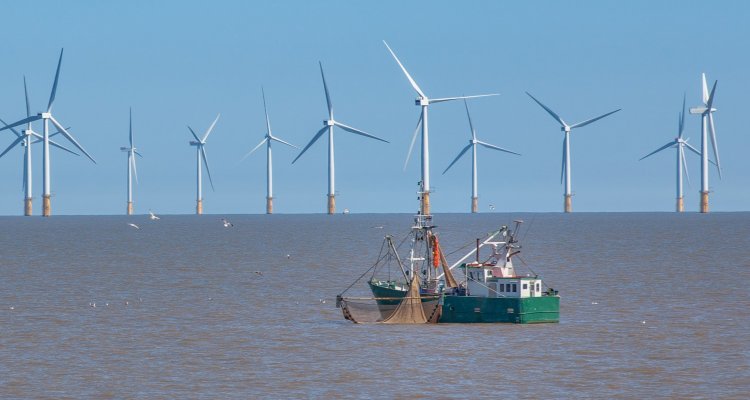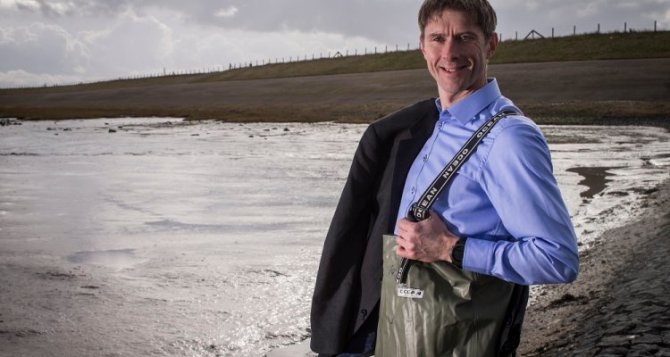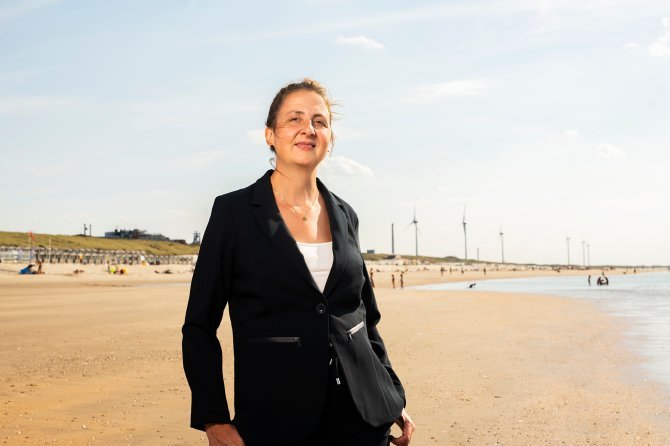
News
What will the jam-packed sustainable North Sea look like in the future?
The North Sea is to provide the Netherlands with climate-neutral energy, consist of 30% nature reserves, provide food for fisheries and aquaculture and fulfil another six functions. How will all that fit and succeed?
The Netherlands aims to construct many solar and wind parks to reduce the use of fossil energy. However, earmarking suitable areas for construction in the tiny and highly populated Netherlands is met with protests from residents. Hence, the government has started focusing on the North Sea. The North Sea is to become Europe’s green energy plant in 2050. The most recent ambitions are to construct a network of wind parks at sea with a total of 5000 wind turbines capable of producing 70 gigawatts of power. Enough to meet the Netherlands’ energy demand so that fossil energy can be phased out and the Netherlands meets the goals set in the Climate Agreement.
Wind parks take up a considerable amount of space. According to the Netherlands Environmental Assessment Agency (PBL), the planned 5000 wind turbines will take up between 17% and 26% of the Dutch territory in the North Sea. The Dutch continental shelf has an area almost one-and-a-half times the size of the Netherlands: 59,000 km2.
10% nature reserves to be assigned
At the same time, the Netherlands’ ambitions to improve biodiversity in the North Sea are far-reaching. The government and environmental organisations agreed to designate 30% of the Dutch continental shelf as a nature reserve in the North Sea Agreement. There are currently seven Natura2000 areas in the North Sea, including the Voordelta, Noordzeekustzone, the Klaverbank and the Doggersbank. Combined, they add up to 20% of the Dutch North Sea area, which means another 10% of nature reserves are to be assigned.
Many populations of fish have shown recovery in recent years. Seals and porpoises are increasing in numbers, while the concentration of poisons and nitrogen is declining. There is less waste in the sea, and bottom trawling, which damages the sea floor, has been reduced. Despite all these positive developments, nature in the North Sea is insufficiently resilient, and its recovery is too slow, according to the PBL. The agency has developed four possible future scenarios for the North Sea, including the “ Sustainable Together” scenario with ambitious climate and diversity targets. In this sustainable scenario, the food web is to be restored with many different fish species, stingrays and sharks, requiring at least 35%, but possibly as much as 50% of the total North Sea area.

Fisheries, transport, defense and recreation
And then there are the other uses of the North Sea. The fisheries industry catches plaice, sole and herring. There are essential shipping routes that cover some 6%. There are 4500 kilometres worth of pipes and 6000 kilometres of cables on the sea bed, covering 13% of its area. The army uses 7% for flight training, oil and gas are mined at 160 locations, and there is sand mining and recreation.
The key question in the PBL study was how the limited space in the North Sea could best be used. Multiple purposes, i.e. using a single spot for different functions, are key, according to the agency. Moreover, no one knows what effect extensive wind parks will have, nor what the nature network in the North sea should look like if we want to achieve our climate and nature goals. Hence, much exploratory research is currently being done in the North Sea.
WUR studies the ecological impact of wind parks in its Wind at Sea Ecological Programme (WASEP). As part of this ten-year research programme, WUR measures wind turbines’ impact on fish and marine mammals such as seals and porpoises. How do the sounds and tremors affect them? Using planes, satellites and algorithms, they assess how many birds perish due to turbines at sea.
Dead sea gulls and northern gannets
Wind parks at sea are home to many seagulls and northern gannets, says Wageningen Marine Research ecologist Martin Baptist. Calculations show that an average of slightly less than one gull and one northern gannet die as a result of collisions against a wind turbine per year. Baptist agrees this is a small number, but if the number of turbines reaches 5000 in 2050, that means 3650 gulls and 4400 northern gannets will perish every year. ‘And that is an issue, because in the long term there won't be so many seagulls and gannets left. That is why we are now looking into ways to scare the seabirds away from the turbines.’

Moreover, WUR tries to determine the effect of wind turbines on bats. ‘Bats hang around windturbines because of the high insect population. Bats have excellent sonar but still occasionally peris due to accidents and variations in pressure. We don’t have a clear picture yet.’
There are more ecological effects, says colleague Josien Steenbergen of Wageningen Marine Research. ‘Large rocks on the seabed keep the wind turbines in place. These rocks could be arranged to form a breeding ground for fish. Another option is to construct artificial reefs in between the wind turbines. We want to study what happens beneath the surface near wind turbines and what rock formations and reefs lead to new habitats for fish.’
Wat gebeurt er onder water na de aanleg van windparken?
Steenbergen expects a decline in fisheries in the coming years, in keeping with the stipulations in the North sea Agreement. The catch areas will be further limited by the construction of wind parks and the creation of nature reserves. Moreover, the high cost of diesel fuel is currently causing the accelerated reduction of the fleet, which was already feeling the effects of the ban on pulse fishing. Since there is no sustainable alternative for fishing sole and plaice, what remains will be ‘ sustainable fisheries within the ecological boundaries’, according to the plans.
The government predicted a reduction in gas and oil mining in the North Sea four years ago, but the invasion of Ukraine by Russia has thwarted these plans. In this new reality, the rigs in the North sea will remain operational for the time being. Oil mining and nature development may even be temporarily combined.

Steenbergen expects a new activity to emerge in the North Sea: aquaculture. Experiments with so-called “marine farms” are already underway. Here, seaweed and mussels are grown. That is also possible in wind parks. Wind park owners have declined such initiatives to date for safety and accessibility reasons. Still, these functions could be combined with sound guidelines, Steenbergen says. She also sees a limiting factor: ‘Aquaculture uses nutrients in the seawater that could also be used by fish. We must consider carefully how many nutrients are available and how much aquaculture can be developed without putting other species at risk.’
Her colleague Baptist does not have high hopes for aquaculture at sea. ‘I wonder what the business case is for a seaweed farm at sea. Everything breaks there. The installation is continuously in motion and must withstand storms. The saltwater affects the materials it is made of, and unexpected algae growth occurs. It is expensive, and there are easier and cheaper places to develop the biobased economy.’
Floating solar parks
Baptist expects a new sector in the North Sea. He was involved in the “The Netherlands in 2120” map in which WUR researchers designed a climate-proof Netherlands. ‘We expect to have floating solar parks at sea in a few decades.’
Baptist also stresses that sand mining is an under-illuminated function of the North Sea that merits more attention. The Netherlands mines sand from the North Sea to construct buildings and roads and for its coastal defences. The sand is mined from a designated area just off the coast. The demand for sand will increase in the coming years. At the same time, there are other functions in part of the designated area, possibly causing a bottleneck in the future, says Baptist.
If we were to mine sand in a more extensive area, more soil life in the upper layer of the soil would be destroyed
‘Sand mining destroys the seabed. To date, sand has only been mined from shallow pits, no deeper than two metres, which fill up again soon, thus restoring the seabed. If we were to mine sand in a more extensive area, more soil life in the upper layer of the soil would be destroyed- - that soil life is in the upper half-metre. It will also increase the costs. Alternatively, sand could be extracted from deeper -six metre- pits, increasing the seabed’s recovery time. To assess the effects of this approach, you need to consider the fact that the North Sea’s undercurrent carries young sole, plaice and dab to the breeding grounds near the shore. The question is how the sand mining pits affect this undercurrent. With this approach, we will study the ecological impact of sand mining.’
Baptist intends to include his knowledge in a serious game. ‘A game that contains all of the North Sea’s user functions. We will then add data, for example, where we wish to mine for sand. The game then calculates the effects mining will have on the ecology and fisheries, thus producing a sound sand mining strategy.’
Gardening in a submerged nature reserve
While research on sand mining pits, wind parks, marine farms and nature reserves continues, so does the construction of wind parks. The plan is to have 1700 wind turbines constructed by 2030. ‘That puts pressure on our research to yield fast results’, Steenbergen says. Much of the research focuses on combining different functions and the effects thereof. ‘But there is also the fundamental question of whether we should be gardening in a submerged nature reserve. Or should we leave parts of the North Sea entirely untouched?’
No one knows what the North Sea will look like one century from now, but Martin Baptist offers a surprising conclusion. “The Netherlands in 2120” map shows remains of large-scale wind parks in the North Sea. ‘These parks are built to last 30 years, by which time there may well be new and more efficient technology. I believe we will have an entirely different energy source in a hundred years. I expect the remnants of the wind turbines in the sea will be used for different purposes.’